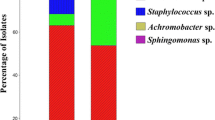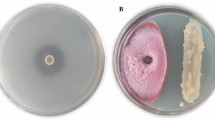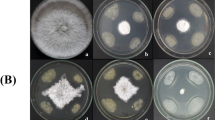Abstract
The present study describes the identification and polyphasic characterization of salt tolerant bacilli displaying plant growth promoting and broad spectrum antifungal activities. A total of 110 strains were isolated, out of which nine were selected on the basis of halotolerance, in vitro plant growth promoting attributes and antagonism against multiple phytopathogens. Preliminary identification of strains was done on the basis of phylogenetic analysis and comparison of 16S RNA sequences with type strains. The test strains were identified as Bacillus pumilus, B. subtilis, B. licheniformis, B. safensis and B. cereus. These strains possess ability to tolerate high salt (8–10% NaCl), form endospore, showed broad spectrum antifungal activity and therefore might cope with adverse environments. Scanning electron microscopy of promising test strains (CG18 and CM25) and pathogen interaction indicated destruction of fungal mycelia by halotolerant antagonists due to cytoplasmic extrusion. Moreover, PCR amplification of bacillomycin (bmyB), chitinase (ChiA), and β-glucanase genes and production of hydrolytic enzymes suggested that test strains could have a role to manage plant pathogens under saline conditions. Finally, the selected strains exhibited some plant growth promotion traits. Overall, this study demonstrated that the evaluated strains could be useful in developing microbial products to enhance tolerance to biotic and abiotic stresses and boost plant growth.




Similar content being viewed by others
References
Ahemad, M., & Kibret, M. (2014). Mechanisms and applications of plant growth promoting rhizobacteria: current perspective. Journal of King Saud University - Science, 26, 1–20.
Albarracín Orio, A. G., Brücher, E., & Ducasse, D. A. (2016). A strain of Bacillus subtilis subsp. subtilis shows a specific antagonistic activity against the soil-borne pathogen of onion Setophoma terrestris. European Journal of Plant Pathology, 144, 217–223.
Ali, S., Hameed, S., Imran, A., Iqbal, M., & Lazarovits, G. (2014). Genetic, physiological and biochemical characterization of Bacillus sp. strain RMB7 exhibiting plant growth promoting and broad spectrum antifungal activities. Microbial Cell Factories, 13, 1–15.
Bric, J. M., Bostock, R. M., & Silverstone, S. E. (1991). Rapid in situ assay for indoleacetic acid production by bacteria immobilized on a nitrocellulose membrane. Applied and Environmental Microbiology, 57, 535–538.
Cappuccino, J., & Sherman, N. (1992). Microbiology: A laboratory manual (Vol. 125, p. 179). New York: Benjamin/Cummings Pub. Co.
Chowdhury, S. P., Hartmann, A., Gao, X., & Borriss, R. (2015). Biocontrol mechanism by root-associated Bacillus amyloliquefaciens FZB42 – a review. Frontiers in Microbiology, 6, 780.
Dey, R., Pal, K., Bhatt, D., & Chauhan, S. (2004). Growth promotion and yield enhancement of peanut (Arachis hypogaea L.) by application of plant growth-promoting rhizobacteria. Microbiological Research, 159, 371–394.
Diomandé, S. E., Nguyen-The, C., Guinebretière, M.-H., Broussolle, V., & Brillard, J. (2015). Role of fatty acids in Bacillus environmental adaptation. Frontiers in Microbiology, 6, 813.
Esitken, A., Yildiz, H. E., Ercisli, S., Donmez, M. F., Turan, M., & Gunes, A. (2010). Effects of plant growth promoting bacteria (PGPB) on yield, growth and nutrient contents of organically grown strawberry. Scientia Horticulturae, 124, 62–66.
Felsenstein, J. (1985). Confidence limits on phylogenies: an approach using the bootstrap. Evolution, 39, 783–791.
Flowers, T. J., Gaur, P. M., Gowda, C. L., Krishnamurthy, L., Samineni, S., Siddiqu, e. K. H., Turner, N. C., Vadez, V., Varshney, R. K., & Colmer, T. D. (2010). Salt sensitivity in chickpea. Plant, Cell & Environment, 33, 490–509.
Gajbhiye, A., Rai, A. R., Meshram, S. U., & Dongre, A. (2010). Isolation, evaluation and characterization of Bacillus subtilis from cotton rhizospheric soil with biocontrol activity against Fusarium oxysporum. World Journal of Microbiology and Biotechnology, 26, 1187–1194.
Glick, B. R. (2014). Bacteria with ACC deaminase can promote plant growth and help to feed the world. Microbiological Research, 169(1), 30–39.
Gupta, B., & Huang, B. (2014). Mechanism of salinity tolerance in plants: physiological, biochemical, and molecular characterization. International Journal of Genomics, 2014, 1–18, Article ID 701596. https://doi.org/10.1155/2014/701596.
Hugenholtz, P., Goebel, B. M., & Pace, N. R. (1998). Impact of culture-independent studies on the emerging phylogenetic view of bacterial diversity. Journal of Bacteriology, 180, 4765–4774.
Jasrotia, P., Kashyap, P. L., Bhardwaj, A. K., Kumar, S., & Singh, G. P. (2018). Scope and applications of nanotechnology for wheat production: a review of recent advances. Wheat and Barley Research, 10(1), 1–14. https://doi.org/10.25174/2249-4065/2018/76672.
Joshi, R., & Gardener, B. M. (2006). Identification of genes associated with pathogen inhibition in different strains B. subtilis. Phytopathology, 96, 145–154.
Jukes, T. H., & Cantor, C. R. (1969). Evolution of protein molecules. In H. N. Munro (Ed.), Mammalian protein metabolism (pp. 21–132). New York: Academic Press.
Kanekar, P. P., Nilegaonkar, S. S., Sarnaik, S. S., & Kelkar, A. S. (2002). Optimization of protease activity of alkaliphilic bacteria isolated from an alkaline lake in India. Bioresource Technology, 85, 87–93.
Kashyap, P. L., Rai, P., Srivastava, A. K., & Kumar, S. (2017). Trichoderma for climate resilient agriculture. World Journal of Microbiology and Biotechnology, 33, 155. https://doi.org/10.1007/s11274-017-2319-1.
Kasim, W. A., Gaafar, R. M., Abou-Ali, R. M., Omar, M. N., & Hewait, H. M. (2016). Effect of biofilm forming plant growth promoting rhizobacteria on salinity tolerance in barley. Annals of Agricultural Science, 61, 217–227.
Kaur, P., Kaur, J., Kaur, S., Singh, S., & Singh, I. (2014). Salinity induced physiological and biochemical changes in chickpea (Cicer arietinum L.) genotypes. Journal of Applied and Natural Science, 6, 578–588.
Kiely, P., Haynes, J., Higgins, C., Franks, A., et al. (2006). Exploiting new systems-based strategies to elucidate plant-bacterial interactions in the rhizosphere. Microbial Ecology, 51, 257–266.
Kloepper, J. W., Leong, J., Teintze, M., & Schroth, M. N. (1980). Enhanced plant growth by siderophores produced by plant growth-promoting rhizobacteria. Nature, 286, 885–886.
Li, D., Nie, F., Wei, L., Wei, B., & Chen, Z. (2007). Screening of high-yielding biocontrol bacterium Bs-916 mutant by ion implantation. Applied Microbiology and Biotechnology, 75, 1401–1408.
Lorck, H. (1948). Production of hydrocyanic acid by bacteria. Physiologia Plantarum, 1, 142–146.
Maxton, A., Singh, P., & Masih, S. A. (2017). ACC deaminase-producing bacteria mediated drought and salt tolerance in Capsicum annuum. Journal of Plant Nutrition. https://doi.org/10.1080/01904167.2017.1392574.
Mehta, S., & Nautiyal, C. S. (2001). An efficient method for qualitative screening of phosphate-solubilizing bacteria. Current Microbiology, 43, 51–56.
Mora, I., Cabrefiga, J., & Montesinos, E. (2015). Cyclic Lipopeptide biosynthetic genes and products, and inhibitory activity of plant-associated Bacillus against Phytopathogenic Bacteria. PLoS One, 10, e0127738.
Natarajan, A., Kumar, K., Madhuri, K., & Usharani, K. G. (2016). Isolation and characterization of salt tolerant plant growth promoting rhizobacteria from plants grown in tsunami affected regions of Andaman and Nicobar islands. Geomicrobiology Journal, 33, 942–947. https://doi.org/10.1080/01490451.2015.1128994.
Nene, Y., Reddy, M., Haware, M., Ghanekar, A., Amin, K., Pande, S., Sharma, M. (2012). Field diagnosis of chickpea diseases and their control. Information Bulletin No. 28 (revised) International Crops Research Institute for the Semi-Arid Tropics.
Pande, S., Rao, J. N., & Sharma, M. (2007). Establishment of the chickpea wilt pathogen Fusarium oxysporum f. sp. ciceris in the soil through seed transmission. Plant Pathology Journal, 23, 3–6.
Penrose, D. M., & Glick, B. R. (2003). Methods for isolating and characterizing ACC deaminase-containing plant growth-promoting rhizobacteria. Physiologia Plantarum, 118, 10–15.
Pikovskaya, R. I. (1948). Mobilization of phosphorus in soil in connection with vital activity of some microbial species. Microbiology, 17, 362–370.
Rai, P., Sharma, A., Saxena, P., Soni, A., et al. (2015). Comparison of molecular and phenetic typing methods to assess diversity of selected members of the genus Bacillus. Microbiology, 84, 236–246.
Ramaiah, N., Hill, R. T., Chun, J., Ravel, J., et al. (2000). Use of a chiA probe for detection of chitinase genes in bacteria from the Chesapeake Bay. FEMS Microbiology Ecology, 34, 63–71.
Renwick, A., Campbell, R., & Coe, S. (1991). Assesment of in vivo screening systems for potential biocontrol agents of Gaeumannomyces graminis. Plant Pathology, 40, 524–532.
Saitou, N., & Nei, M. (1987). The neighbor-joining method: a new method for reconstructing phylogenetic trees. Molecular Biology and Evolution, 4, 406–425.
Schwyn, B., & Neilands, J. (1987). Universal chemical assay for the detection and determination of siderophores. Analytical Biochemistry, 160, 47–56.
Shafi, J., Tian, H., & Ji, M. (2017). Bacillus species as versatile weapons for plant pathogens: a review. Biotechnology and Biotechnological Equipment, 31, 446–459. https://doi.org/10.1080/13102818.2017.1286950.
Shakeel, M., Rais, A., Hassan, M. N., & Hafeez, F. Y. (2015). Root associated Bacillus sp. improves growth, yield and zinc translocation for basmati rice (Oryza sativa) varieties. Frontiers in Microbiology, 6, 1286.
Sharan, A., Darmwal, N. S., & Gaur, R. (2008). Xanthomonas campestris, a novel stress tolerant, phosphate-solubilizing bacterial strain from saline–alkali soils. World Journal of Microbiology and Biotechnology, 24, 753–759.
Sharma, A., Singh, P., Kumar, S., Kashyap, P. L., Srivastava, A. K., Chakdar, H., Singh, R. N., Kaushik, R., Saxena, A. K., & Sharma, A. K. (2015). Deciphering diversity of salt-tolerant bacilli from saline soils of eastern indo-gangetic plains of India. Geomicrobiology, 32, 170–180.
Shrestha, B. K., Karki, H. S., Groth, D. E., Jungkhun, N., & Ham, J. H. (2016). Biological control activities of rice-associated Bacillus sp. strains against sheath blight and bacterial panicle blight of rice. PLoS One, 11(1), e0146764.
Shrivastava, P., & Kumar, R. (2015). Soil salinity: a serious environmental issue and plant growth promoting bacteria as one of the tools for its alleviation. Saudi Journal of Biological Sciences, 22, 123–131.
Siddikee, M. A., Chauhan, P. S., Anandham, R., Han, G. H., & Sa, T. (2010). Isolation, characterization, and use for plant growth promotion under salt stress, of ACC deaminase-producing halotolerant bacteria derived from coastal soil. Journal of Microbiology and Biotechnology, 20(11), 1577–1584.
Siddiqui, S., Siddiqui, Z. A., & Ahmad, I. (2005). Evaluation of fluorescent Pseudomonads and Bacillus isolates for the biocontrol of a wilt disease complex of pigeonpea. World Journal of Microbiology and Biotechnology, 21, 729–732.
Singh, R. K., Kumar, D. P., Singh, P., Solanki, M. K., Srivastava, S., Kashyap, P. L., Kumar, S., Srivastava, A. K., Singhal, P. K., & Arora, D. K. (2014). Multifarious plant growth promoting characteristics of chickpea rhizosphere associated Bacilli help to suppress soil-borne pathogens. Plant Growth Regulation, 73, 91–101.
Smibert, R., & Krieg, N. (1994). Phenotypic characterization. Methods for general and molecular bacteriology. In Methods for general and molecular microbiology (pp. 607–654). Washington, DC: ASM Press.
Solanki, M. K., Robert, A. S., Singh, R. K., Kumar, S., Pandey, A. K., Srivastava, A. K., & Arora, D. K. (2012a). Characterization of mycolytic enzymes of Bacillus strains and their bio-protection role against Rhizoctonia solani in tomato. Current Microbiology, 65, 330–336.
Solanki, M. K., Kumar, S., Pandey, A. K., Srivastava, S., Singh, R. K., Kashyap, P. L., Srivastava, A. K., & Arora, D. K. (2012b). Diversity and antagonistic potential of Bacillus spp. associated to the rhizosphere of tomato for the management of Rhizoctonia solani. Biocontrol Science and Technology, 22, 203–217.
Solanki, M. K., Singh, R. K., Srivastava, S., Kumar, S., Kashyap, P. L., & Srivastava, A. K. (2015). Characterization of antagonistic-potential of two Bacillus strains and their biocontrol activity against Rhizoctonia solani in tomato. Journal of Basic Microbiology, 55, 82–90.
Srivastava, R., Tripathi, B. M., Singh, R. K., Srivastva, P., Kumari, P., et al. (2013). Profiling of plant growth promoting bacteria associated with Jaunpuri giant raddish rhizosphere. International Journal of Agriculture, Environment & Biotechnology, 6(2), 187–196.
Stein, T. (2005). Bacillus subtilis antibiotics: structures, syntheses and specific functions. Molecular Microbiology, 56, 845–857.
Turner, N. C., Colmer, T. D., Quealy, J., Pushpavalli, R., Krishnamurthy, L., Kaur, J., Singh, G., Siddique, K. H. M., & Vadez, V. (2013). Salinity tolerance and ion accumulation in chickpea (Cicer arietinum L.) subjected to salt stress. Plant and Soil, 365, 347–361.
Vejan, P., Abdullah, R., Khadiran, T., & Ismail, S. (2016). Role of plant growth promoting rhizobacteria in agricultural sustainability—A review. Molecules, 21, 573.
Versalovic, J., Schneider, M., de Bruijn, F. J., & Lupski, J. R. (1994). Genomic fingerprinting of bacteria using repetitive sequence-based polymerase chain reaction. Methods in Molecular and Cellular Biology, 5, 25–40.
Yadav, S., Kaushik, R., Saxena, A. K., & Arora, D. K. (2011). Diversity and phylogeny of plant growth-promoting bacilli from moderately acidic soil. Journal of Basic Microbiology, 51, 98–106.
Yuan, W. M., & Crawford, D. L. (1995). Characterization of streptomyces lydicus WYEC108 as a potential biocontrol agent against fungal root and seed rots. Applied and Environmental Microbiology, 61, 3119–3128.
Zahid, M., Abbasi, M. K., Hameed, S., & Rahim, N. (2015). Isolation and identification of indigenous plant growth promoting rhizobacteria from Himalayan region of Kashmir and their effect on improving growth and nutrient contents of maize (Zea mays L.). Frontiers in Microbiology, 6, 207.
Zhao, Y., Selvaraj, J. N., Xing, F., Zhou, L., Wang, Y., Song, H., Tan, X., Sun, L., Sangare, L., Folly, Y. M. E., & Liu, Y. (2014). Antagonistic action of Bacillus subtilis strain SG6 on Fusarium graminearum. PLoS One, 9(3), e92486.
Acknowledgements
The authors thanks to Director, ICAR-NBAIM, Maunath Bhanjan (U.P.) for providing necessary support for conducting the research work.
Author information
Authors and Affiliations
Corresponding authors
Ethics declarations
Conflict of interest
The authors declare that they have no conflict of interest.
Research does not involve human participants and/or animals.
Electronic supplementary material
ESM 1
(DOCX 41 kb)
Rights and permissions
About this article
Cite this article
Sharma, A., Kashyap, P.L., Srivastava, A.K. et al. Isolation and characterization of halotolerant bacilli from chickpea (Cicer arietinum L.) rhizosphere for plant growth promotion and biocontrol traits. Eur J Plant Pathol 153, 787–800 (2019). https://doi.org/10.1007/s10658-018-1592-7
Accepted:
Published:
Issue Date:
DOI: https://doi.org/10.1007/s10658-018-1592-7




